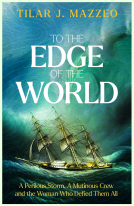
The Last Emperor of Mexico
A Disaster in the New World
by Edward Shawcross
This title was previously available on NetGalley and is now archived.
Send NetGalley books directly to your Kindle or Kindle app
1
To read on a Kindle or Kindle app, please add kindle@netgalley.com as an approved email address to receive files in your Amazon account. Click here for step-by-step instructions.
2
Also find your Kindle email address within your Amazon account, and enter it here.
Pub Date 20 Jan 2022 | Archive Date 30 Nov 2021
Faber and Faber Ltd | Faber & Faber
Talking about this book? Use #TheLastEmperorofMexico #NetGalley. More hashtag tips!
Description
'One of the most monstrous enterprises in the annals of international history,' said Karl Marx. 'A madness without parallel since Don Quixote,' said a future French president. This is history's judgement on the events surrounding the ill-fated reign of Maximilian of Mexico, the young Austrian archduke who in 1864 crossed the Atlantic to assume a faraway throne.
He had been convinced to do so by a duplicitous Napoleon III. Keen to spread his own interests abroad, the French emperor promised Maximilian a hero's welcome, which he would ensure with his own mighty military support. Instead, Maximilian walked into a bloody guerrilla war - and with a headful of impractical ideals and a penchant for pomp and butterflies, the so-called new emperor was singularly unequipped for the task. The ensuing saga would feature the great world leaders of the day, popes, bandits and queens; intrigue, conspiracy and cut-throat statecraft, as Mexico became the pivotal battleground in the global balance of power, between Old Europe and the burgeoning force of the New World: American imperialism.
The Last Emperor of Mexico is the vivid history of this barely known, barely believable episode - a bloody tragedy of operatic proportions, and a vital debacle, the effects of which would be felt into the twentieth century and beyond.
Available Editions
| EDITION | Other Format |
| ISBN | 9780571360574 |
| PRICE | £20.00 (GBP) |
Average rating from 7 members
Featured Reviews
I am grateful to NetGalley for providing an advance copy of this book in exchange for my honest review.
The subtitle of this book is “The Dramatic Story of the Habsburg Archduke Who Created a Kingdom in the New World”.
Having worked in and travelled to the region many times in recent years, it is remiss of me not to know more about the history of Mexico. This book goes a long way towards addressing my knowledge, at least regarding the mid 19th century events covered and the circumstances that made these events possible. This book provides a fascinating insight into a little known, or perhaps little understood period of Mexican history. Following periods of internal conflict, unstable governments and US interventions, the French military, under orders from Napoleon III, occupied the main cities of Mexico and installed a European Prince as Emperor.
Being familiar with Manet’s painting “The Execution of Emperor Maximilian”, I already knew the outcome of the main protagonist. Nevertheless I knew little of the events leading up to his rule and his downfall.
The book provides some history regarding the waring parties in Mexico (essentially Liberals vs a loose coalition of Conservatives, Imperialists and the Church ) which eventually led to the French plan. This was to stabilise the country, expand France’s influence in the New World and enforce debt repayments. The reign of Napoleon III in France was to be to model followed by Mexico. While in the Americas, the US had a policy, the Monroe Doctrine, of exerting leadership and power in the region. The ongoing Civil War distracted the US from this policy, allowing the French to plan an expansion in Mexico and potentially elsewhere.
Exactly how Maximilian becomes Emperor of Mexico is covered in some detail. The Austrian Prince was unlikely to succeed his older brother to the throne in Austria. Although he had a tenuous relationship to the first, Spanish emperor of Mexico, Maximilian was eventual choice to be the second emperor due to circumstances of European imperialism and expansion. This outcome is largely due to the influence of Napoleon III on Europe in general and Maximilian in particular. Napoleon III promised to provide French military, economic and technical support to the Empire. In addition to French expansion and debt repayments, Napoleon III hoped the Empire would allow expansion and safeguard European interests throughout the New World.
Although a capable, experienced and respected European Royal, with proven leadership, technical and bureaucratic skills, Maximilian had grand ambitions; Mexico provided an opportunity outside the restrictions he was subject to in Europe. His young wife, a Belgium Princess, also somewhat unfulfilled in her life, was also prominent in encouraging her husband and pursuing the creation of an Empire.
The early chapters discuss the confluence of circumstances leading up to Maximilian and his wife being installed in Mexico. A complex, lengthy and stressful process for all concerned ! The French, Austrian, Belgium governments and royalty all supported the French plans; the British government and royalty were somewhat ambivalent. Very few of those involved urged Maximilian not to accept the French offer. Influential Mexican expatriates in France supported the Conservative cause at home. They inevitably and strongly supported the plans to form an Empire, which would establish and maintain a stable Mexican State in the Americas. An areas fast becoming dominated by US power and influence.
The book subsequently covers the establishment of the Empire, only possible with the intervention of French, Belgium, Austrian and other foreign troops in what is essentially an ongoing civil war. For some three years Maximilian rules Mexico with abundant foreign troops but limited local support. Despite the best endeavours of Maximilian and his wife to provide stability via compromise, liberal attitudes and modern thinking, inevitably the foreign intervention is not successful.
The downfall of the Empire is covered in the later chapters of the book. Again a confluence of circumstances lead to this downfall and the author documents the events and the individuals involved. European support is diminished as the Empire struggles to provide stability. Debt repayment remains an issue, in part due to the onerous costs of hosting the French and European military plus other foreign officials in Mexico. Church support for the Empire is limited until the issue of ownership of property and land, confiscated during periods of Liberal Government, is resolved. The end of the US Civil War allows the American government to once again exert influence in the Mexico region. The presence of a non-democratic, imperialist European power south of the border is not tolerable to a powerful and dominant USA.
After some three years of Empire with little progress and little chance of success, Napoleon III’s patience is tested. Following the departure of other European troops, the withdrawal of the final French troops and bureaucracy leaves Maximilian’s Empire exposed to the reality of civil war once again. The opposition Liberals growth in strength and power due to US military support. To the end, Maximilian retains the best of intentions for his Empire. Although somewhat deluded and foolhardy his intentions be, they are nevertheless sincere and honourable. He remains in Mexico, does not abdicate as requested by the French and European powers. He ventures from the safety of Mexico City to lead his remaining forces against the encroaching Liberals.
Eventually the scene captured in Manet’s paintings takes place.The author provides an Epilogue to the whole “monumental gamble”, noting the outcomes and subsequent lives of the main protagonists. His conclusion on Maximilian is nuanced. He was a capable and intelligent man, liberal, enlightened and generous in his attitudes and actions. However he was also misguided, misled and deluded. Once military support was removed, his very limited local support was evident and the outcomes inevitable.
I thoroughly enjoyed this book which covers events largely forgotten or at least misunderstood, in Mexican, European and US history. The author takes the reader on a journey leading up to Maximilian’s installation in Mexico, establishing & maintaining the Empire and inevitably the downfall. Leading and supporting characters are portrayed with honesty, clarity and occasionally humour. Events and actions are supported by extensive research of archives in Mexico, the US and Europe.
The author concludes that the imperialist expansionist events portrayed in the book are not unique to the past, as subsequent imperialist or expansionist plans led to conflicts and interventions throughout the 20th century and up until the present day. The quote 'Those who do not learn history are doomed to repeat it’ seems especially apt and poignant after reading this book.
A thoroughly researched, well written and engaging book with occasional illustrations, abundant notes, selected references and an index. I highly recommend it to anyone with an interest in Mexico, the US and Europe during the 19th Century. I wish the author and all involved in bringing this book to publication, all the very best






